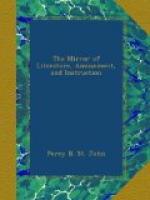THE MIRROR OF LITERATURE, AMUSEMENT, AND INSTRUCTION.
Vol. 10, No. 286.] Saturday, December 8, 1827. [Price 2d.
* * * * *
[Illustration: Caxton’s House in the Almonry, Westminster.]
To expatiate on the advantages of printing, at this time of day, would be “wasteful and ridiculous excess.” We content ourselves with the comparison of Dryden’s
“Long trails of light descending down.”
In a retrospective glance at our previous volumes (for can the phrenologists tell us of a head capacious enough to contain their exhaustless variety?) our readers will perceive that, from time to time, sundry “accounts” of the origin and progress of printing have been inserted in the mirror;[1] and though we are not vain enough to consider our sheet as the “refined gold, the lily, the violet, the ice, or the rainbow,” of the poet’s perfection, yet in specimens of the general economy of the art, the long-extended patronage of the public gives us an early place.
With an outline of the life of Caxton our readers must be already familiar; but we wish them to consider the above accurate representation of the first English PRINTER’S residence as antecedent to a Memoir of Caxton, in which it will be our aim to concentrate, in addition to biographical details, many important facts from the testimony of antiquarians; for scarcely a volume of the Archaeologia has appeared without some valuable communication on Caxton and his times.
In the meantime we proceed with the locale of Caxton’s house, situate on the south-west of Westminster Abbey, where was formerly the eleemosynary, or almonry, where the alms of the abbots were distributed. Howell in his Londinopolis, describes this as “the spot where the abbot of Westminster permitted Caxton to set up his press in the Almonry, or Ambry,” the former of which names is still retained. This is confirmed by Newcourt, in his Repertorium, who says, “St. Anne’s, an old chapel, over against which the Lady Margaret, mother to king Henry VII., erected an alms-house for poor women, which is now turned into lodgings for singing-men of the college. The place wherein this chapel and alms-house stood was called the Eleemosinary, or Almonry, now corruptly called the Ambry, (Aumbry,) for that the alms of the abbey were there distributed to the poor; in which the abbot of Westminster erected the first press for book-printing that was in England, about the year of Christ 1471, and where William Caxton, citizen and mercer of London, who first brought it into England, practised it.” Here he printed The Game and Play of the Chesse, said to be the first book that issued from the press in this country.
Hence, according to Mr. M’Creery, the intelligent author of “The Press,” a poem, “the title of chapel to the internal regulations of a printing-office originated in Caxton’s exercising the profession in one of the chapels in Westminster Abbey, and may be considered as an additional proof, from the antiquity of the custom, of his being the first English printer."[2]




